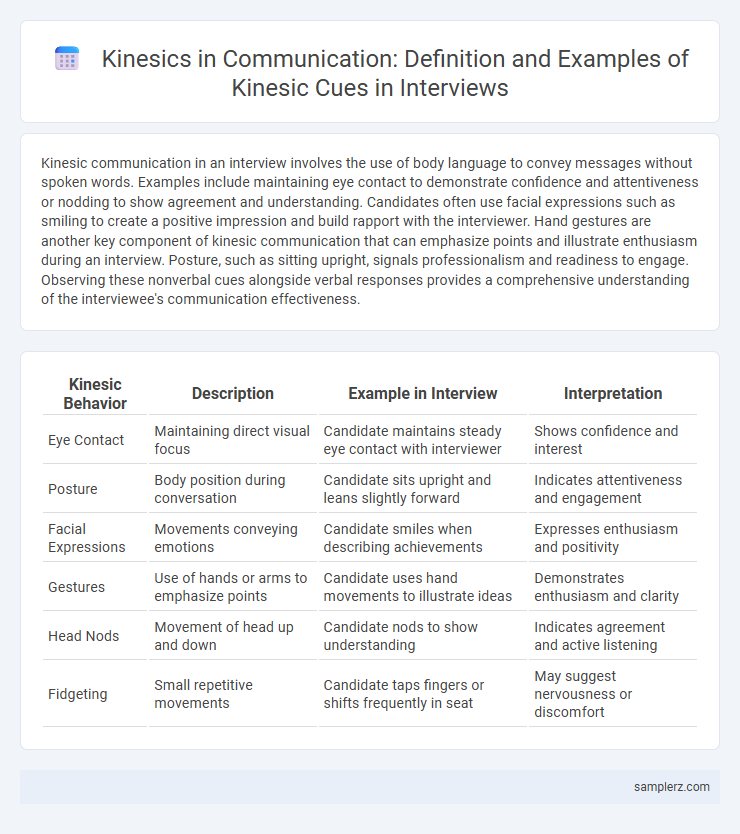Kinesic communication in an interview involves the use of body language to convey messages without spoken words. Examples include maintaining eye contact to demonstrate confidence and attentiveness or nodding to show agreement and understanding. Candidates often use facial expressions such as smiling to create a positive impression and build rapport with the interviewer. Hand gestures are another key component of kinesic communication that can emphasize points and illustrate enthusiasm during an interview. Posture, such as sitting upright, signals professionalism and readiness to engage. Observing these nonverbal cues alongside verbal responses provides a comprehensive understanding of the interviewee's communication effectiveness.
Table of Comparison
| Kinesic Behavior | Description | Example in Interview | Interpretation |
|---|---|---|---|
| Eye Contact | Maintaining direct visual focus | Candidate maintains steady eye contact with interviewer | Shows confidence and interest |
| Posture | Body position during conversation | Candidate sits upright and leans slightly forward | Indicates attentiveness and engagement |
| Facial Expressions | Movements conveying emotions | Candidate smiles when describing achievements | Expresses enthusiasm and positivity |
| Gestures | Use of hands or arms to emphasize points | Candidate uses hand movements to illustrate ideas | Demonstrates enthusiasm and clarity |
| Head Nods | Movement of head up and down | Candidate nods to show understanding | Indicates agreement and active listening |
| Fidgeting | Small repetitive movements | Candidate taps fingers or shifts frequently in seat | May suggest nervousness or discomfort |
Understanding Kinesics in Interviews
Kinesics in interviews involves the study of body language, such as gestures, facial expressions, and posture, to interpret the interviewee's true feelings and attitudes. For example, maintaining eye contact can signal confidence and engagement, while crossed arms might indicate defensiveness or discomfort. Understanding these nonverbal cues enhances interviewers' ability to assess candidates beyond their verbal responses, improving communication accuracy.
Types of Kinesic Behaviors Observed
During an interview, kinesic behaviors such as facial expressions, eye contact, and hand gestures provide critical nonverbal cues that influence communication effectiveness. Smiling can signal openness and confidence, while frequent eye contact demonstrates attentiveness and honesty. Hand gestures often emphasize points or illustrate ideas, enhancing the clarity and engagement of the conversation.
Facial Expressions and Their Meanings
Facial expressions in interviews, such as a genuine smile, indicate openness and confidence, fostering positive rapport between interviewer and candidate. Furrowed brows may signal confusion or concern, prompting clarification of questions for accurate communication. Maintaining consistent eye contact paired with subtle nods conveys attentiveness and engagement, enhancing interpersonal connection during the interview process.
Eye Contact: Building Trust and Rapport
Maintaining steady eye contact during an interview signals confidence and attentiveness, fostering trust between the interviewer and candidate. Consistent eye engagement helps establish rapport, making the conversation more authentic and engaging. Avoiding excessive blinking or glaring strikes a balance that supports positive kinesic communication in professional settings.
Posture and Its Impact on Perception
Upright posture during an interview conveys confidence and professionalism, significantly influencing the interviewer's perception of the candidate's competence and reliability. Leaning slightly forward can demonstrate engagement and interest, while slouching may be interpreted as disinterest or lack of enthusiasm. Kinesic cues such as posture play a crucial role in nonverbal communication, shaping the overall impression and outcome of the interview process.
Hand Gestures: Enhancing Verbal Communication
Hand gestures in an interview, such as open palms or purposeful finger movements, enhance verbal communication by emphasizing key points and conveying confidence. Controlled hand movements help clarify messages and engage the interviewer, making the speaker appear more dynamic and trustworthy. Strategic use of kinesics strengthens overall communication effectiveness and aids in leaving a positive impression.
Nervous Movements and Interview Anxiety
Nervous movements during an interview, such as fidgeting, tapping fingers, or avoiding eye contact, are common kinesic indicators of interview anxiety. These nonverbal cues can signal discomfort or lack of confidence, impacting the interviewer's perception of the candidate. Understanding and managing these kinesic behaviors helps improve communication effectiveness and project greater self-assurance.
Mirroring Techniques in Interview Settings
Mirroring techniques in interview settings involve subtly replicating the interviewer's body language, such as posture, gestures, and facial expressions, to build rapport and foster trust. For example, if the interviewer leans forward and nods, the interviewee might mirror these actions to create a sense of connection and engagement. Research in communication studies shows that effective mirroring can enhance mutual understanding and increase the likelihood of a positive interview outcome.
Cultural Variations in Kinesic Communication
Kinesic communication in interviews varies significantly across cultures, with gestures such as eye contact, facial expressions, and body posture conveying different meanings; for example, direct eye contact is valued in Western cultures as a sign of confidence, while in some Asian cultures it may be considered disrespectful. The cultural context influences how interviewees interpret nodding, smiling, or hand movements, affecting the overall communication process during interviews. Understanding these variations is crucial for interviewers to avoid misinterpretations and foster effective intercultural dialogue.
Tips for Positive Kinesic Impressions
Maintaining open body posture, such as uncrossed arms and leaning slightly forward, signals attentiveness and confidence during an interview. Consistent eye contact aligns with active engagement and fosters trust between interviewer and candidate. Controlled hand gestures complement verbal responses by emphasizing key points without causing distraction.

example of kinesic in interview Infographic
 samplerz.com
samplerz.com